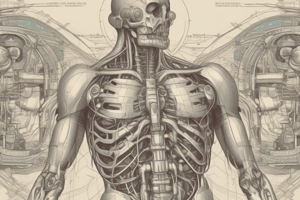Podcast
Questions and Answers
Which system is responsible for the production and distribution of blood throughout the body?
Which system is responsible for the production and distribution of blood throughout the body?
- Respiratory system
- Digestive system
- Nervous system
- Circulatory system (correct)
Which of the following is NOT a component of the skeletal system?
Which of the following is NOT a component of the skeletal system?
- Bones
- Muscles (correct)
- Joints
- Cartilage
What structures are included in the endocrine system?
What structures are included in the endocrine system?
- Heart and blood vessels
- Ductless glands (correct)
- Kidneys and bladder
- Lungs and trachea
Which major organ system is primarily responsible for gas exchange in the body?
Which major organ system is primarily responsible for gas exchange in the body?
Which of the following systems includes the mouth and intestines?
Which of the following systems includes the mouth and intestines?
What does physiology primarily study?
What does physiology primarily study?
In anatomical position, which of the following is correct?
In anatomical position, which of the following is correct?
Which body plane divides the body into anterior and posterior sections?
Which body plane divides the body into anterior and posterior sections?
What term describes a structure located towards the head end of a body?
What term describes a structure located towards the head end of a body?
Which of the following best describes the term 'medial' in anatomy?
Which of the following best describes the term 'medial' in anatomy?
What anatomical term is used to refer to the palm of the hand?
What anatomical term is used to refer to the palm of the hand?
What term is used to describe a structure that is farther away from the trunk?
What term is used to describe a structure that is farther away from the trunk?
Which of the following pairs of terms are both directional terms used in anatomy?
Which of the following pairs of terms are both directional terms used in anatomy?
What position describes lying down face up?
What position describes lying down face up?
Which of the following body cavities contains the urinary bladder?
Which of the following body cavities contains the urinary bladder?
Which quadrants of the abdominopelvic cavity includes the gallbladder?
Which quadrants of the abdominopelvic cavity includes the gallbladder?
What is the primary function of the integumentary system?
What is the primary function of the integumentary system?
Which organ is found in the mediastinal space?
Which organ is found in the mediastinal space?
Which of the following correctly describes the lateral position?
Which of the following correctly describes the lateral position?
What structure is included in the left upper quadrant?
What structure is included in the left upper quadrant?
Which system is primarily responsible for coordinating body activities?
Which system is primarily responsible for coordinating body activities?
In which quadrant would you find the terminal ileum?
In which quadrant would you find the terminal ileum?
Which organ system is involved in removing waste products from the blood?
Which organ system is involved in removing waste products from the blood?
Which one of these is the primary role of the respiratory system?
Which one of these is the primary role of the respiratory system?
What is the largest cavity within the human body?
What is the largest cavity within the human body?
What is the primary function of the endocrine system?
What is the primary function of the endocrine system?
Flashcards
Anatomy
Anatomy
The study of an organism's structure, including size, shape, construction, and organ positions.
Physiology
Physiology
The study of how an organism's functions, focusing on how organs work individually and together.
Anatomical Position
Anatomical Position
A standardized body posture where a person stands erect, facing forward, feet slightly apart, arms hanging down with palms forward.
Median Plane
Median Plane
Signup and view all the flashcards
Sagittal Plane
Sagittal Plane
Signup and view all the flashcards
Coronal Plane
Coronal Plane
Signup and view all the flashcards
Transverse Plane
Transverse Plane
Signup and view all the flashcards
Superior
Superior
Signup and view all the flashcards
Lesser curvature
Lesser curvature
Signup and view all the flashcards
Erect position
Erect position
Signup and view all the flashcards
Supine position
Supine position
Signup and view all the flashcards
Prone position
Prone position
Signup and view all the flashcards
Lateral position
Lateral position
Signup and view all the flashcards
Cranial cavity
Cranial cavity
Signup and view all the flashcards
Spinal cavity
Spinal cavity
Signup and view all the flashcards
Pleural cavities
Pleural cavities
Signup and view all the flashcards
Pericardial cavity
Pericardial cavity
Signup and view all the flashcards
Mediastinal space
Mediastinal space
Signup and view all the flashcards
Abdominal cavity
Abdominal cavity
Signup and view all the flashcards
Pelvic cavity
Pelvic cavity
Signup and view all the flashcards
Right upper quadrant
Right upper quadrant
Signup and view all the flashcards
Left upper quadrant
Left upper quadrant
Signup and view all the flashcards
Right lower quadrant
Right lower quadrant
Signup and view all the flashcards
Skeletal System
Skeletal System
Signup and view all the flashcards
Muscular System
Muscular System
Signup and view all the flashcards
Nervous System
Nervous System
Signup and view all the flashcards
Digestive System
Digestive System
Signup and view all the flashcards
Circulatory System
Circulatory System
Signup and view all the flashcards
Study Notes
Anatomy and Physiology Overview
- Anatomy is the study of the structure of an organism, including size, shape, construction, and organ positions.
- Physiology is the study of the functions of an organism, how organs work independently and as a whole.
Anatomical Position
- Anatomical position: Person stands erect, facing forward, feet forward and apart, arms hanging down, palms forward. A standardized view for consistent anatomical descriptions.
Body Planes
- Median plane: Divides the body into right and left halves.
- Sagittal plane: Divides the body parallel to the median plane.
- Coronal (frontal) plane: Divides the body into front and back portions.
- Transverse plane: Divides the body into upper and lower portions.
- Oblique plane: Divides the body at an angle.
Directional Terms
- Superior: Above
- Inferior: Below
- Anterior: Front
- Posterior: Back
- Proximal: Closer to the point of attachment
- Distal: Farther from the point of attachment
- Medial: Toward the midline
- Lateral: Away from the midline
- Internal: Inside
- External: Outside
- Deep: Further from the surface
- Superficial: Closer to the surface
- Central: Located in the center
- Peripheral: Located towards the outside
- Parietal: Referring to the membrane lining the body cavity.
- Visceral: Referring to the membrane covering the organs.
- Cephalic: Referring to the head.
- Caudal: Referring to the tail or tail end.
- Palmar: Referring to the palm of the hand.
- Plantar: Referring to the sole of the foot.
- Greater curvature: Outer and longer portion of a curved structure.
- Lesser curvature: Inner and shorter portion of a curved structure.
- Erect: Standing or sitting upright.
- Supine: Lying face up (dorsal recumbent position, for anterior surgeries).
- Prone: Lying face down
- Lateral: Lying on one side
Body Regions
- Head: Contains brain, components of mouth, nose, eyes, ears, and glands.
- Trunk: Includes neck, back, chest, abdomen, pelvis, perineum and vital organs.
- Limbs: Include arms, legs, hands, and feet (non-essential for life).
Body Cavities
- Cranial cavity: Houses the brain and pituitary gland.
- Spinal cavity: Contains spinal cord.
- Pleural cavities: Contain one lung each.
- Pericardial cavity: Contains the heart.
- Mediastinal space: Contains the thymus gland, trachea, esophagus, bronchi, ends of the vena cavae, beginning of the aorta.
- Abdominal cavity: Holds the stomach, liver, gallbladder, spleen, pancreas, most of the intestines, kidneys.
- Pelvic cavity: Houses the urinary bladder, sex organs, part of the large intestine (cecum, appendix, rectum).
Abdominopelvic Quadrants
- Right upper quadrant (RUQ): Part of the small intestine, upper ascending colon, most of the liver, gallbladder, bile ducts, head of the pancreas, right adrenal gland, right kidney, upper part of the right ureter.
- Left upper quadrant (LUQ): Ascending part of the duodenum, upper descending colon, left half transverse colon, spleen, small part of the liver, left adrenal gland, left kidney, upper part of the left ureter, stomach.
- Right lower quadrant (RLQ): Lower ascending colon, cecum, appendix, lower right ureter, terminal ileum, part of the urinary bladder, sex organs.
- Left lower quadrant (LLQ): Lower descending colon, small intestine (part of ileum), part of the urinary bladder, sex organs.
Body Structure Organization
- Cell: Fundamental unit
- Tissue: Group of cells
- Organ: Group of tissues
- Organ system: Group of organs
- Organism: Complete living entity
Major Organ Systems
- Integumentary system: External protection, temperature regulation, sensation, waste excretion
- Skeletal system: Support and protection
- Muscular system: Movement and support
- Nervous system: Coordination and communication
- Special senses: Sight, smell, hearing, and taste
- Digestive system: Processes food
- Circulatory system: Transports materials
- Respiratory system: Gas exchange (oxygen and carbon dioxide)
- Urinary system: Waste removal
- Reproductive system: Reproduction
- Endocrine system: Regulation through hormones
- Immune system: Defense against disease
Organ System Components
- Integumentary: Skin, hair, nails, glands
- Skeletal: Bones, joints, cartilage, connective tissue
- Muscular: Skeletal, smooth, and cardiac muscles
- Nervous: Brain, spinal cord, peripheral nerves
- Special Senses: Eyes, ears, nose, taste buds
- Digestive: Mouth, pharynx, esophagus, stomach, intestines, accessory organs
- Circulatory: Heart, blood vessels, blood, lymph tissues
- Respiratory: Lungs, nose, pharynx, larynx, trachea
- Urinary: Kidneys, ureters, bladder, urethra
- Reproductive: Sex organs and ducts
- Endocrine: Ductless glands
- Immune: White blood cells, antibodies
Studying That Suits You
Use AI to generate personalized quizzes and flashcards to suit your learning preferences.





